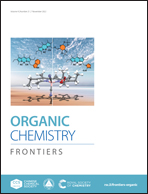Electrochemical C–H functionalization to synthesize 3-hydroxyalkylquinoxalin-2(1H)-ones via quinoxalin-2(1H)-ones and aldehydes†
Abstract
Direct C3-functionalization of quinoxalin-2(1H)-ones is a convenient way to develop new and sustainable strategies, which are important for natural product and drug modification. Herein, we report an electrocatalytic C–H activation method, which synthesized 3-hydroxyalkylquinoxalin-2(1H)-ones via a radical pathway using unprotected quinoxalin-2(1H)-ones and aliphatic aldehydes as the substrates. This electrolysis strategy avoids the use of stoichiometric oxidants and heavy metal catalysts. Further scale-up studies in electrochemical continuous flow reactors have demonstrated the potential application value.



 Please wait while we load your content...
Please wait while we load your content...